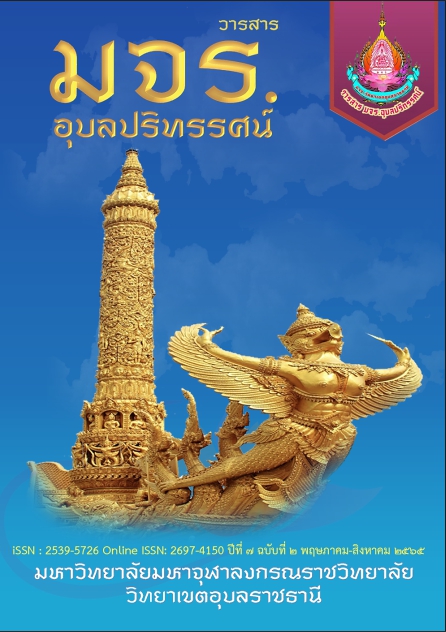AN APPLICATION OF BALA 4 FOR BUDDHIST TOURISM PROMOTION OF HUATHANON TEMPLE, SADAO DISTRICT, SONGKHLA PROVINCE
Main Article Content
Abstract
This research aimed 1) to study the concept in promoting Buddhist tourism of Wat Hua Thanon, Sadao District, Songkhla, 2) to investigateBala principle in Theravada Buddhist scriptures, and 3) to apply the Bala principle for Buddhist tourism promotion of Wat Hua Thanon, Sadao District, Songkhla. This was a qualitative and documentary research with interview and descriptive form of presentation. The results were as follows: 1) Regarding concept ofpromotingBuddhisttourism, it was found that Wat Hua Thanon is a temple with Buddhist tourism for tourists to visit orworship holy objects such asthe Buddha’s relics and the stature of Luang Poo Tuad, for the auspicious blessing of life,family according to some tourists’ belief. In addition, there are some visiting programs architecturalart, sculpture,and cultural festivals organized by the temple for some groups of visitors. Also, Wat Hua Road canattract visitors to both Thais and foreign tourists to come and relax in a variety of ways daily under the management of the current abbot. Tourism management focuses on not only Buddhism but also other religion like Narai Kasian Samut sculpture, an artwork that has been beautifully created to enhance spiritual value to the public. Therefore, Wat Hua Road is considered as the temple that truly benefits visitors. 2) Concerning the Bala(power) in TheravadaBuddhist scriptures, it was found that Bala (power) consists of 4 principles: Pannà-bala(power of wisdom) helping Buddhist screate opportunities for life, living withknowledge, ability, creativeness through the process of careful and right thought, 2) Viriya-bala (power of energy or diligence) generating a guideline for the pursuit of love, satisfaction caused by contemplating, constantly checking properly, 3) Anavajja-bala (power of faultlessness) promoting rightfulness, adjusting for justice, reducing social integrity with strictly performing duty determined by the honest physical, verbal and mental, and 4) Sangaha-bala(power of sympathy or solidarity) helping, cooperating harmoniously, sacrifice, goodwill, discarding greed, anger, and passion withhonest, cleaned transparent physical, verbal, and mind and helping others constantly according on one’s own ability. 3) With regard to a guideline forthe application of Balaprinciple in promotingBuddhisttourism of Wat Hua Thanon, Sadao District, Songkhla Province,it was found that the principle of Bala is appropriate and in line with the context of Buddhist tourism of Wat Hua Thanon, which focuses on providing services in all aspects to tourists and pilgrims. That shows the power of creativity (Pannà-bala),the power of the pursuit (Viriya-bala (power of energy) in which tourists lack the major factors in the pursuit in many aspects, both concrete and abstract, the power of adaptation (Anavajja-bala), in which humans must also adapt to nature, social, environment, and humans together to coexist peacefully. The main point is that tourists must adjust their behavior to everything, every situation for stability in life, to make peace for all parties. The power of cooperation and cooperation (Sangaha-bala)isimportant, valuable and beneficial to the society, nature, environment, which must be contributed to each other.
Article Details
References
พระมหาสุทิตย์อาภากโร (อบอุ่น). การท่องเที่ยวแนวพุทธ. จุลสารการท่องเที่ยว. ปีที่ 18 เล่มที่ 1 2542.
ภัทร์สุภา ลีลานภาพรรณ์. (2551). “การท่องเที่ยวเชิงพุทธ : ศึกษาเฉพาะกรณีแหล่งวัฒนธรรมในกรุงเทพมหานคร”. บัณฑิตวิทยาลัย: มหาวิทยาลัยมหามกุฏราชวิทยาลัย,
วีรณัฐ โรจนประภา. (2559). “การนำหลักพุทธธรรมมาประยุกต์ใช้ในการสร้างสังคมแห่งสัมมาปัญญาในประเทศไทย”. บัณฑิตวิทยาลัย: มหาวิทยาลัยศรีปทุม,
ภวัต นิตย์โชติ. (2560) “การพัฒนาสมรรถนะตามหลักพละ 4 ของบุคลากรปกครองส่วนท้องถิ่นในจังหวัดสงขลา”. บัณฑิตวิทยาลัย:: มหาวิทยาลัยมหาจุฬาลงกรณราชวิทยาลัย,
พระอลงกรณ์ ฐานสิริ (แก้ววิเศษ). (2561) “ศึกษาแนวทางส่งเสริมการท่องเทียวเชิงพุทธของวัดพระพุทธรูป 9 ส. ในจังหวัดหนองคาย”. บัณฑิตวิทยาลัย: มหาวิทยาลัยมหาจุฬาลงกรณราชวิทยาลัย.
มหาจุฬาลงกรณราชวิทยาลัย. (2539) พระไตรปิฏกภาษาไทย ฉบับมหาจุฬาลงกรณราชวิทยาลัย, กรุงเทพฯ :โรงพิมพ์มหาจุฬาลงกรณราชวิทยาลัย.

